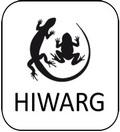About us
About Us
Hampshire is fortunate that the county covers a huge geographic area and a very diverse breadth of habitat including: the Isle of Wight, the New Forest National Park, the South Downs National Park, as well as many other unspoiled areas, including Woolmer Forest.
It is therefore unsurprising that we are host to 12 out of the 13 native amphibians and reptiles in UK, including rarities such as the Natterjack Toad, Sand Lizard and Smooth Snake, and wherever you live in the county there will be opportunities to survey and monitor an assemblage of amphibian and reptile species.
HIWARG formed in the Autumn of 2018 and is an affiliated independent ARG-UK group. The group focus is conservation of native UK species essentially around habitat management, surveying, public engagement, volunteer training & doing as much as possible to understand & protect the native species in the county.
All members are volunteers with a common interest.
If you have some spare time and would like to be involved with HIWARG, maybe you have taken a photo of a reptile or amphibian and would like it identified or maybe you have some other query, then please do get in contact info@hiwarg.org.uk
CONSERVATION THROUGH EMPATHY BY ENGAGEMENT
We now have a new website. Please visit https://hiwarg.org/
Visit HIWARG's Redbubble Shop to support our work www.redbubble.com/people/HIWARG/shop
News
News
South East Regional ARGs Meeting 8th October
Copied and pasted from the ARG UK Facebook page:
For those unable to attend (and for those who did), DICE PhD student Steve Allain has aptly summarised the spirit of the SE Regional ARGs Meeting held on 8th October at the University of Kent in his blog.
Suckers for Amphibians update
There have been a few big steps in the #suckers4amphibians project since #HIWARG and #reptilariumIOW began their investigations into a very specific leech feeding behaviour in 2020.
Last year ARG UK promoted the project which led to several organisations joining us on our journey. Angela also gave a presentation on the project last Sunday to the First Global Amphibian and Reptile Disease Conference #GARD2022 in Tennessee, USA.
We can also for the first time, give a name to the "unknown leech". We have had suspicions for some time, but thanks to an initial ID by Buglife which was confirmed by DNA tests by Garden Wildlife Health and the University of Silesia four of the cases we hav received are a non-native leech from the Genus Batracobdella.
Yesterday, we had another report come in of a toad with leeches on its eyes, throat and limbs... but this time outside of the two known clusters in South Devon and the Isle of Wight. Hopefully we will get a sample off soon for ID.
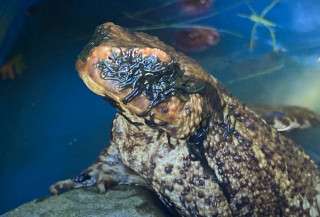
How you can help
- Email us with sightings and we can advise on next steps and organise samples amphibians@hiwarg.org.uk
- Complete the survey form at www.reptilarium.org/leech-survey
Handling and the collection of samples
Please wear gloves when handling an infected animal for biosecurity purposes - and wash any containers or other materials that have held the amphibian with disinfectant. The target leech is also known to attach to humans!
Do not try to remove leeches yourself, contact us in the first instance and we will guide further. However, the following points detail some basic steps:
- Place the amphibian in a container with water to encourage some of the leeches to detach themselves. These can be collected and isolated for sampling. It is best to place something in the tank for the amphibian to leave the water if it wishes or to avoid drowning.
- You could ask a local vet or wildlife hospital to remove leeches for you, but inform them that we need the leeches preserved in good condition for ID purposes.
- We will send you a vial of 70% ethanol to preserve the leeches for analysis, but very strong vodka can also be used to preserve them if you don’t have or receive ethanol.
- Please note, this project is not intended to persecute leeches. We are investigating a specific type of feeding behaviour, species identification and distribution of the leeches involved to better understand the dynamics and impacts. Leeches are an important component of biodiversity and form an important part of the food chain themselves.
Visit the following websites for more information:
https://www.facebook.com/groups/455730808110700
https://www.reptilarium.org/leech-survey
Midwife Toads in Winchester
Midwife Toads are a non native species to the UK, but have been found in several colonies in parts of the country. Hampshire has been named as one of these locations in several sources, but there are no actual records that we are aware of. Despite the lack of records, there is an anecdotal comment on a website to suggest that Midwife Toads were known from the Littleton area and so we are reaching out to residents for their help in recording these elusive toads.
Midwife Toads are smaller than our native toads, with adults reaching around 5cm in length. They can also be distinguished by their eyes, if you are lucky enough to spot one, which have vertical pupils as opposed to horizontal/oval pupils of our two native toads. By far the best way to identify the presence of Midwife Toads is by their calls, which has been likened to “an electronic beep, like a smoke alarm with a dying battery or a New Age car alarm” by Steve Allain, one of the lead national researchers of Midwife Toads. A big difference with these toads is that they are not as reliant on ponds for breeding, as the male toads carry the eggs wrapped around their back legs, hence their name. Breeding usually takes place between April and June so they should have been calling for a few weeks now.
We are hoping that residents of Littleton, Weeke and Sparsholt areas in particular, as well as the surrounding areas will be willing to help both Steve Allain and HIWARG, by listening out on warm damp nights for the “beeping” toads. If you do hear these calls it would be really helpful if you can record the calls on your phone, or take photos if you manage to see one. We will be arranging surveys of the Littleton area in the coming weeks, so you may see us walking the roads in small listening for calls. We will be walking at night with torches, HIWARG branded clothing (group leaders) and maybe hi vis, so feel free to come and chat to us.
HIWARG will be organising surveys of these areas to listen for calling toads and will also be surveying Littleton Pond for amphibians and other freshwater species. We are reaching out to other parishes and Winchester Council for permission to survey other ponds to give us, and the relevant authorities, a better understanding of biodiversity in the area.
CALLING MIDWIFE TOADS
Visit Steve’s blog to hear a sample of several Midwife Toads calling http://stevenallain.co.uk/Blog/scifri-whats-that-beeping-in-my-garden
A pair of midwife toads calling https://www.youtube.com/watch?v=SVPK899UwV8&t=37s
For all sightings/recordings, please contact us on:
HIWARG: info@hiwarg.org.uk or www.facebook.com/groups/455730808110700
Steve Allain: www.facebook.com/SJRAllain or https://twitter.com/stevoallain
Big Green Frog Hunt 2022
 CITIZEN SCIENCE SURVEYS FOR THE NON-NATIVE WATER FROG SPECIES
CITIZEN SCIENCE SURVEYS FOR THE NON-NATIVE WATER FROG SPECIES
Water or Green Frogs (Marsh F278874032_10160272623883057_2741040197175943514_n.jpgrog, Southern Clade Pool Frog and Edible Frog) have started calling in earnest again and are now entering their breeding period.
If you want to help us understand their distribution, which enables us to monitor their spread and potential impact if any, they are one of the easiest species to survey for. All you do is go for a walk alongside canals, ponds and other wetland areas on really sunny days and just listen out for their easily recognised calls. With a bit of patience you can get fairly close to take photos which also help with any IDs.
The map below shows the known locations of water frogs in Hampshire and across the borders into Dorset, Sussex, Surrey, Berkshire and Wiltshire. You can use this map to plan your trip. Areas with good access for parking and walking and for hearing water frogs are Basingstoke Canal between Fleet and Farnborough, the Denny Wood area of the New Forest, the RSPB reserves near Selsey, W Sussex and the Alice Holt/Frensham Ponds area. Two other spots that would be good to clarify records are the Haverstock Road area of Bournemouth for DARN and the Afton area on the Isle of Wight.
Check out the videos of calling Marsh Frog and Pool Frogs which show the two vocal sacs that all of the Water Frogs have. The native Common Frog has a single, less obvious vocal sac in its throat.
Marsh Frog: https://www.youtube.com/watch?v=yyEhHLlVuQ8
Pool Frog: https://www.youtube.com/watch?v=8lGMvBj4mvE
You can also download the ARGUK/ARC amphibian ID guide which has a useful section on the Water Frogs https://www.arguk.org/info-advice/id-guides/441-amphibian-id-guide-revised-2019-pdf
Key ID features to differentiate from Common Frogs:
- Marsh Frogs and Edible Frogs are larger than Common Frogs, but Pool Frogs are roughly the same size.
- A much more pointed, conical nose
- Eyes are closer together and more prominent
- two obvious raised lines on the sides of the back
- Sometimes has a green/yellow line down its spine
- Lacking the dark patch behind the eyes
- Very long back legs and can jump a considerable distance.
- Calling very loudly during the day (watch above vids)
Pics have been added below to show the range of colouration and ID features.
I hope to arrange a couple of open events in a few weeks to survey targeted areas once we get a few records in so get recording on Record Pool and watch this space. https://www.recordpool.org.uk/
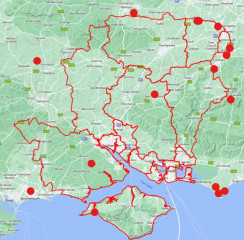
BIG GREEN FROG HUNT
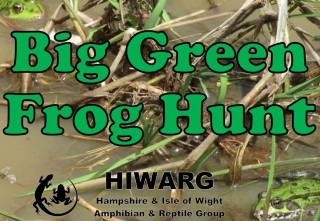
Help us to map the distribution of water frogs in Hampshire and the Isle of Wight.
Visit our website, click on the "Record a Sighting" tab and log your observation. Unless your sighting has been ID'd by a specialist to species level, it is always best to record them as "water frogs" https://groups.arguk.org/hiwarg
Water frogs (also known as Green Frogs) are a complex of three non-native frogs:
-
Marsh frogs
-
Southern Pool frogs (Note: Northern Pool frogs are considered native and are a protected species, but are not found in Hampshire)
-
Edible frogs (hybrid of the above two species)
They are found in several locations around Hampshire and the Isle of Wight, but our knowledge of their exact distribution or their impact on native species is poor. They have been known to carry the amphibian disease, Chytridiomycosis, but grass snake populations in particular seem to benefit anecdotally. We would like to understand more about the water frogs in Hampshire, IoW and in neighbouring counties. See the map below for where we have had one or more records and help us to expand on what we know.
Calls
You can listen to their calls, along with other amphibians here: https://www.froglife.org/drag.../animals/adults/adult-calls/
More info
You can read more information on Water/Green frogs here: https://www.froglife.org/.../amphibians-and.../green-frogs/
Or read up on their interbreeding dynamics on SARGs website here https://surrey-arg.org.uk/SARGWEB.php?app=WaterFrogs and their genetics here https://surrey-arg.org.uk/SARGWEB.php?app=WaterFrogGenetics
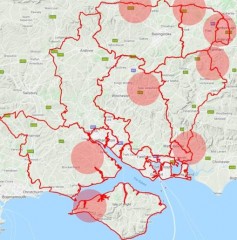
Join up or Log In
Join up or Log In
Members sign in here
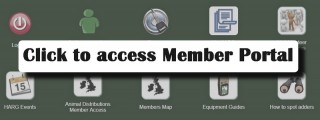
OR
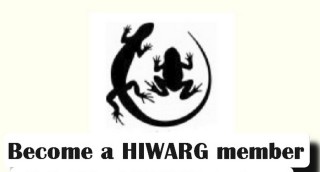
Membership costs just £6.00 per year as a subscription that can be cancelled at any time.
Your membership will help HIWARG to protect the amphibians & reptile of Hampshire.
Be aware of and take part in conservation opportunities, surveys and many other activities across the county.
Click here to go directly to PayPal to subscribe as a member:
Donate to HIWARG
Donate to HIWARG
Info & ID guides
Info & ID guides
Identification Guides
Amphibian Identification - downloadable colour cards : a great ID guide from ARG UK/ARC
Newt Eggs & Larvae - downloadable colour cards : an excerpt from the above guide, specifically on newt eggs and larvae
Its a small newt but which one : a HIWARG guide to help differentiate smooth newts and palmate newts
Reptile Identification - downloadable colour cards : a great ID guide from ARG UK/ARC
Non-Native Species ID Sheets (NNSS Website) : ID sheets from the Non Native Species Secretariat
Alien Amphibian and Reptile Species in the UK : A bilingual guide (English/Welsh) from ARC
Projects & Citizen Science
#BigGreenFrogHunt: Southern Clade Pool Frogs calling A YouTube video of southern clade pool frogs calling in North Hampshire
#BigGreenFrogHunt: Marsh frogs calling
DARN's 'Slow Worms in Churchyards' project
'Amphibians & Reptiles on Allotments' Introduction Leaflet
"Spawn Spotters" presentation 12 Jan 2021
Toad Patrol presentation 12 Jan 2021
Gotta love a larva presentation 9 July 2021
HIWARG Video: Spawn Spotters and Toad Patrols Jan 2021
HIWARG Video: Amphibian surveys: ID'S & Survey Methods March 2021
Habitat Management and Creation
![]() Reptile Habitat Management Handbook
Reptile Habitat Management Handbook
![]() Amphibian Habitat Management Handbook
Amphibian Habitat Management Handbook
Creating Garden Ponds - downloadable booklet
Creating Ponds for Amphibians and Reptiles (Freshwater Habitats Trust)
Guide to the Restoration, Creation and Management of Ponds (Freshwater Habitats Trust)
Habitat Management guides (Buglife) - Not specifically herp based but a great set of guides
How to Create Invertebrate and Reptile Mounds (Magnificent Meadows)
Creating Grass Snake Egg-laying Heaps (ARG UK and RAVON)
Advice and Information
ARC's "Dogs and Adders" Advice Sheet
"There is a Snake in my Garden - What can I do?" (ARG UK)
Policies/Health & Safety
HIWARG Safeguarding Policy and Protocols June 2020
Buddy System/Lone Working Procedures
ARG UK Generic Risk Assessment July2020
Herp Diseases - Recognise & Report
REPORT SICK OR DEAD WILDLIFE TO GARDEN WILDLIFE HEALTH
Advice Note-4: Amphibian disease precautions - a guide for UK fieldworkers
Reptile Slough Genebank - collection & submission of found sloughs
Garden Wildlife Health - Severe Perkinsea Infection (SPI)
Other
Fixing Enkamat to Gully Pots - Initial Findings in Sussex
Useful glossary of terms often used within the herpetological field. (Credit due - unknown)
Kids stuff - Educational items for the young ones
Pond pack Animal fact sheets Animal colouring sheets
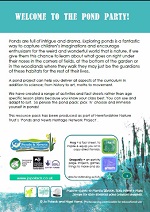
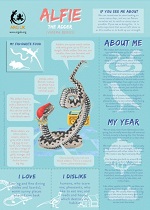
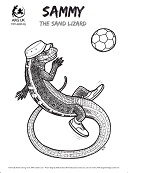
Photo gallery
Photo Gallery
Contact us
Contact Us
If you would like more information about HIWARG or have something to share with us, please get in touch via the link to our social media presence.
Upcoming Events
Upcoming events will be listed here.
Latest News
- Big Green Frog Hunt 2024
21/05/2024 6:16 pm - Midwife Toads in the Winchester (Littleton, Weeke and Teg Down areas in particular) and possibly Colden Common areas
18/06/2023 8:11 pm - Midwife Toads in Hampshire 2023
19/04/2023 11:05 pm - Stuck for something to do over the Easter Weekend?
05/04/2023 11:20 pm - Toads need your help
21/02/2023 12:23 am
© Hampshire And Isle of Wight Amphibian and Reptile Group (HIWARG)
Website hits: 58572
View All | Find out how to get a mini-website for your ARG
© ARG UK Local Groups mini-websites 2025
Wind powered websites by Aye-aye Design.
